Back to top: Overall strategy and initial presuppositions
The specular hypothesis
The initial strategy for Unit J4 was based on presuppositions that turned out to be incorrect. I will elucidate them here in order to explain both the nature of the excavations and the eventual shift from J4 to J6.
The basic assumption was crystallized in the reconstruction shown in the drawing to the right (realized by Paola Pesaresi), wherein I projected a parallel staircase and apron to the east.
|
|
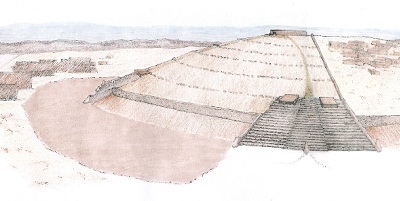 |
Back to top: Overall strategy and initial presuppositions
Reasons for the hypothesis
The main reason for this assumption was the existence of a diagonal wall to the east (in yellow) that seemed indeed specular to the alignment of the western apron and staircase (in red). It was by projecting this line all the way to the south that I assumed there would be a symmetrical staircase with apron to the east.
The main difficulty with this hypothesis was the wall (in black) of which, when we started the excavations in J4, only the western face was showing. In the projection (drawing above), we projected a cuneus at the base of the staircase – admittedly not a very likely solution.
|
|
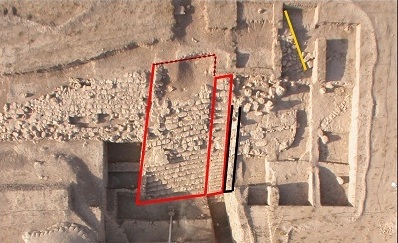 |
Back to top: Overall strategy and initial presuppositions
The evidence from J4
The decisive proof that my assumption was wrong came from the excavations of k100 (the square in red in the photo to the right). We reached a level lower than the matching level of the apron to the west, and we found no trace of stones nor any evidence that the stones might have been removed.
Two other factors militated against the specular hypothesis. First, the diagonal wall (in yellow above) did not continue to the south.
A second counterargument also emerged, more subtle in nature but very significant for a broader understanding of the general situation. The bin f93 showed a marked difference in use between the area to the west (devoid of any such structures) and the one to the east. It gave evidence of a difference in use in the area immediately adjacent to the staircase, and thus explained the nature of the wall flanking the staircase (in black above) as delmiting more sharply the ceremonial area to the west from teh use area to the east.
|
|
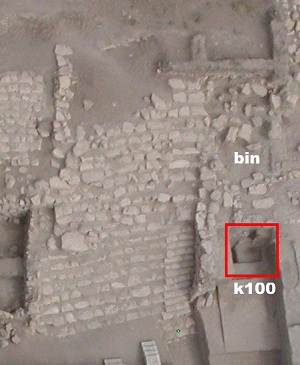 |
Back to top: Overall strategy and initial presuppositions
The boundary hypothesis
The evidence from J4 led us to review thoroughly our understanding of the Temple Terrace as a whole. It was not just the staircase that was asymmetrical, but, in fact, the entire complex. The revised sketch to the right shows how the reconstruction could be preliminarily redrawn to account for the new evidence.
Three elements that had been projected proved to be missing: (1) the large trapezoidal shape consisting of a staircase in the center (split by a wall) and two flanking aprons; (2) the centrality of this staircase vis-à-vis the Terrace, so placed as to be perpendicular to the long axis of the presumed oval Terrace; (3) the very nature of the Terrace as a regular oval with the Temple in the middle (this was emphasized in the 2003 reconstruction, reproduced here in the lower right hand side – drawing by Dana Reemes).
The new conclusion was that the boundary between the ceremonial sphere in the west and the service area in the east was at the very edge of the staircase, not farther east as originally assumed. In other words, the staircase itself was the boundary, marking the edge of both the Terrace and the Plaza in front of it.
|
|
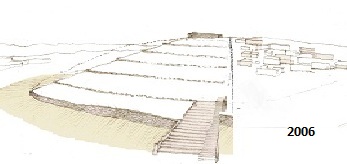
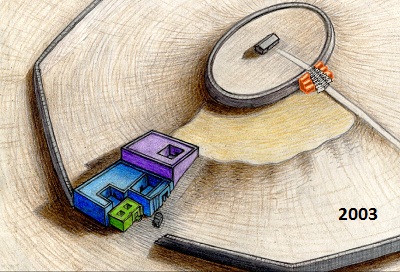 |
Back to top: Overall strategy and initial presuppositions
The shift to J6
| These conclusions set the stage for a wider operation, the one that started in 2008 as J6. Originally aimed at exploring the area south of J4, it became apparent that the continuity to gthe north, along the staircase and thus across J4, constituted an organic whole that was best excavated as a unit. Hence J6 came to subsume J4. The skletch shows the reconstruction of the Temple Terrace after two seasons' work in the new unit.
|
|
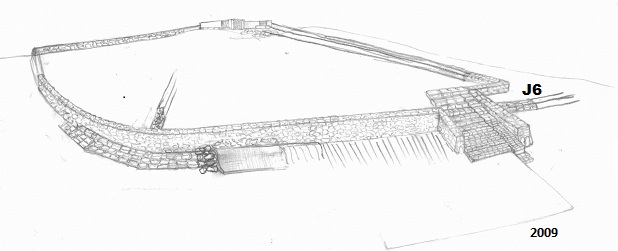 |